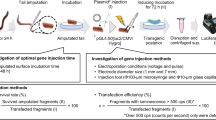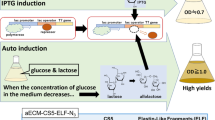Abstract
The large-scale production of recombinant proteins in plants is limited by relatively low yields and difficulties in extraction and purification. These problems were addressed by engineering tobacco plants to continuously secrete recombinant proteins from their roots into a simple hydroponic medium. Three heterologous proteins of diverse origins (green fluorescent protein of jellyfish, human placental alkaline phosphatase [SEAP], and bacterial xylanase) were produced using the root secretion method (rhizosecretion). Protein secretion was dependent on the presence of the endoplasmic reticulum signal peptide fused to the recombinant protein sequence. All three secreted proteins retained their biological activity and, as shown for SEAP, accumulated in much higher amounts in the medium than in the root tissue.
This is a preview of subscription content, access via your institution
Access options
Subscribe to this journal
Receive 12 print issues and online access
$209.00 per year
only $17.42 per issue
Buy this article
- Purchase on Springer Link
- Instant access to full article PDF
Prices may be subject to local taxes which are calculated during checkout



Similar content being viewed by others
References
Conrad, U. & Fiedler, U. Compartment-specific accumulation of recombinant immunoglobulins in plant cells: an essential tool for antibody production of physiological functions and pathogen activity. Plant Mol. Biol. 38, 101–109 (1998).
Firek, S. et al. Secretion of a functional single-chain Fv protein in transgenic tobacco plants and cell suspension cultures. Plant Mol. Biol. 23, 861–870 (1993).
Wongsamuth, R. & Doran, P.M. Production of monoclonal antibodies by tobacco hairy roots. Biotechnology & Bioengineering. 54, 401–415 (1997).
Shepherd, T. & Davies, H.V. Carbon loss from the roots of forage rape (Brassica napus L.) seedlings following pulse-labeling with CO 2. Annals of Botany 72, 155– 163 (1993).
Marschner, H. Mineral Nutrition of Higher Plants (The University Press, Belfast, Northern Ireland, 1986).
Denecke, J., Botterman, J. & Deblaere, R. Protein secretion in plant cells can occur via a default pathway. Plant Cell 2, 51– 59 (1990).
Reichel, C. et al. Enhanced green fluorescence by the expression of an Aequorea victoria green fluorescent protein mutant in mono- and dicotyledonous plant cells. Proc. Natl. Acad. Sci. USA 93, 5888– 5893 (1996).
Berger, J., Hauber, J., Hauber, R., Geiger, R. & Cullen, B.R. Secreted placental alkaline phosphatase: a powerful new quantitative indicator of gene expression in eukaryotic cells. Gene 66, 1–10 (1988).
Herbers, K., Wilke, I., and Sonnewald U. 1995. A thermostable xylanase from Clostridium thermocellum expressed at high levels in the apoplast of transgenic tobacco has no detrimental effects and is easily purified. Bio/Technology 13, 63–66.
Benfey, P.N., Ren, L. & Chua, N-H. The CaMV 35S enhancer contains at least two domains which can confer different developmental and tissue-specific expression patterns. EMBO J. 8, 2195–2202 (1989).
Ni, M., Cui, D. & Gelvin, S.B. Sequence-specific interactions of wound-inducible nuclear factors with mannopine synthase 2' promoter wound responsive elements. Plant Mol. Biol. 30, 77–96 (1996).
Biely, P., Mislovicova, D. & Toman, R. Remazol Brilliant Blue xylan: a soluble chromogenic substrate for xylanases. Methods Enzymol. 160, 536–542 (1988).
Prasher, D.C., Eckenrode, V.K., Ward, W.W., Prendergast, F.G. & Cormier, M.J. Primary structure of the Aequorea victoria green-fluorescent protein. Gene 111, 229–233 (1992).
Borisjuk, N. et al. Calreticulin in plant cells: primary structure, developmentally regulated expression and intracellular distribution. Planta 206 , 504–514 (1998).
Horsch, R.B. et al. A simple and general method for transferring genes into plants. Science 227, 1229–1231 (1985).
Davis, S.J. & Viestra, R.D. Soluble, highly fluorescent variants of green fluorescent protein (GFP) for use in higher plants. Plant Mol. Biol. 36, 521–528 (1998).
Hawes, M.C. & Brigham, L.A. Impact of root border cells on microbial populations in the rhizosphere. Adv. Plant Pathol. 8,119–148 (1992).
Smith, R.A., Duncan, M.J. & Moir, D.T. Heterologous protein secretion from yeast. Science 229, 1219–1224 (1985).
Ursin, V.M. & Shewmaker C.K. Demonstration of a senescence component in the regulation of the mannopine synthase promoter. Plant Physiol. 102, 1033–1036 (1993).
Hood, E.E. et al. Commercial production of avidin from transgenic maize—characterization of transformant, production, processing, extraction and purification. Molecular Breeding 3, 291–306 (1997).
Reisman, H.R. Problems in scale-up of biotechnology product processing. Crit. Rev. Biotechnol. 13, 195–253 (1993).
Bevan, M. Binary Agrobacterium vectors for plant transformation. Nucl. Acids Res. 12, 8711–8721 (1984).
Chomczynski, P. & Sacchi, N. Single-step method of RNA isolation by acid guanidinium thiocyanate-phenol-chloroform extraction. Anal. Biochem. 162, 156– 159 (1987).
Sambrook, J., Fritsch, E.F. & Maniatis, T. Molecular Cloning: A Laboratory Manual (Cold Spring Harbor Laboratory Press, Cold Spring Harbor, NY, 1989).
Terry, M.E. & Bonner, B.A. An examination of centrifugation as a method of extracting an extracellular solution from peas, and its use for the study of indoleacetic acid-induced growth. Plant Physiol. 66, 321–325 (1980).
Acknowledgements
We thank Uwe Sonnewald (Institut fuer Pflanzengenetik, Gatersleben, Germany), Christoph Reichel (Max-Planck Institut fuer Zuechtungsforschung, Koeln, Germany), William Ward and Ralf Kneer (Rutgers University, New Brunswick, NJ), Andrei Golovko (American Cyanamid Corporation, Princeton, NJ), and Stephen Meyer (GEM Biomedical MGM Instruments, Hamden, CT) for technical assistance and advice. This research was supported by Photosynthetic Harvest Inc., International Institute of Cell Biology (Kiev, Ukraine), NJ Agricultural Experimental Station, and the NJ Commission for Science and Technology. I. Raskin has equity in Photosynthetic Harvest Inc.
Author information
Authors and Affiliations
Corresponding author
Rights and permissions
About this article
Cite this article
Borisjuk, N., Borisjuk, L., Logendra, S. et al. Production of recombinant proteins in plant root exudates. Nat Biotechnol 17, 466–469 (1999). https://doi.org/10.1038/8643
Received:
Accepted:
Issue Date:
DOI: https://doi.org/10.1038/8643
This article is cited by
-
Optimized transgene expression in the red alga Porphyridium purpureum and efficient recombinant protein secretion into the culture medium
Plant Molecular Biology (2024)
-
Nicotiana hairy roots for recombinant protein expression, where to start? A systematic review
Molecular Biology Reports (2023)
-
Optimised production of an anti-fungal antibody in Solanaceae hairy roots to develop new formulations against Candida albicans
BMC Biotechnology (2020)
-
Transgenic callus of Nicotiana glauca stably expressing a fungal laccase maintains its growth in presence of organic contaminants
Plant Cell, Tissue and Organ Culture (PCTOC) (2019)



